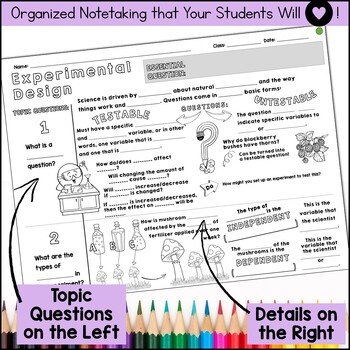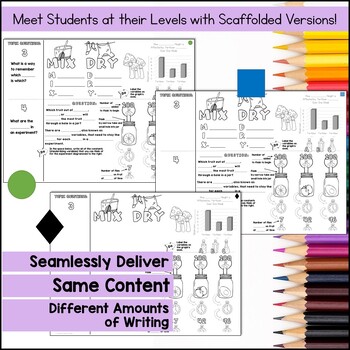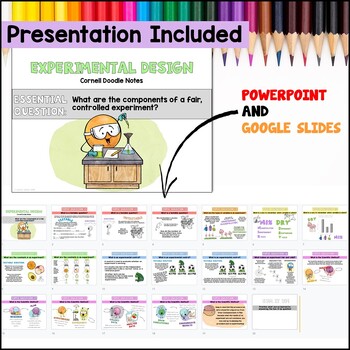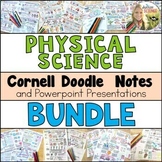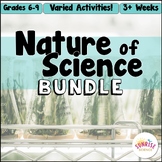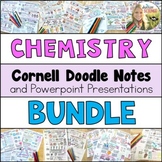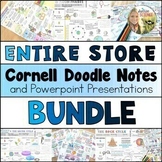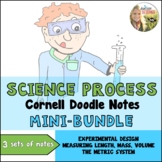Scientific Method Experimental Design Doodle Notes | Middle School Science
- PDF
- Internet Activities
What educators are saying
Also included in
- This is a growing bundle of all of my Physical Science Cornell Doodle Notes. This resource currently contains Cornell Doodle Notes and the associated Powerpoint / Google Slides Presentations for Physical Science 28 topics. The price at this point reflects only what is in the bundle at this time, pluPrice $103.00Original Price $144.12Save $41.12
- Looking for fun and engaging ways to teach your students the foundational practices of science, measuring, and the laboratory that will guide them through the year in your class?This bundle contains over 20 activities to help you teach:lab safetylab equipmentclaim-evidence-reasoning (CER)scientificPrice $47.00Original Price $58.97Save $11.97
- This is a growing bundle of all of my Cornell Doodle Notes on Chemistry topics. This resource currently contains Cornell Doodle Notes and the associated Powerpoint / Google Slides Presentations for 21 topics.✨ If you buy this bundle today, you are receiving 20% off on the current resources, plus youPrice $87.00Original Price $109.15Save $22.15
- This is a bundle of all of my resources for teaching chemistry concepts at the 8th / 9th grade level, including laboratory equipment and safety, states, properties and changes in matter, atoms and the periodic table, and bonding and chemical reactions. These resources include a mix of Cornell DoodlePrice $195.00Original Price $252.47Save $57.47
- This is a bundle of all of my resources for teaching physical science at the middle school level! These resources include a mix of Cornell Doodle Notes, labs, demonstrations, inquiry activities, self-paced digital 5E lessons, manipulatives, projects, pixel art review activities, and assessments. IPrice $297.00Original Price $384.06Save $87.06
- This is a growing bundle of ALL of my Science Cornell Doodle Notes resources. This bundle currently contains Cornell Doodle Notes and the associated Powerpoint / Google Slides Presentations for 48 science topics. The price at this point reflects what is in the bundle at this time, plus 20% off. As aPrice $189.00Original Price $244.25Save $55.25
- This mini-bundle contains three sets of Cornell Doodle Notes for teaching or reviewing about Science Process Skills! The topics included are: Experimental Design / The Scientific Method, The Metric System, and Measuring Length, Volume, and Mass. Get 20% off of these resources by purchasing them in tPrice $12.95Original Price $16.20Save $3.25
Description
These scaffolded Experimental Design and Scientific Method Cornell Doodle Notes can be used to introduce students to the concepts of writing testable questions, defining manipulated (independent), responding (dependent), and standardizing (constant) variables, as well as controls. The notes stress the importance of making precise and accurate measurements, repeating trials, and taking detailed notes during an experiment. The last page of the notes provides a graphic organizer of the scientific method, for which students will fill in details about each phase. It is stressed that the scientific method is a general process for doing science-- not a 'set in stone' process!
This resource can be a stand-alone lesson as it introduces or reviews the vocabulary and basic concepts associated with experimental design via notes and a Powerpoint.
These notes provide background information to support the NGSS Science and Engineering Practice of Planning and Carrying Out Investigations.
Cornell Notes are a note-taking strategy in which topic questions are written in a narrow left-hand column and definitions, explanations, and diagrams are filled in in the right-hand column.
Doodle Notes are another note-taking strategy for which pictures and graphics activate the visual pathways of the brain, which helps with retention of information when compared to standard note-taking. Your visual learners will really benefit from seeing and coloring in the pictures aside the main points of the notes!
What's Included (please see the preview also!):
- The Cornell Doodle Notes are 4-pages each and there are 3 scaffolded versions plus the answer key
- Two presentation options: Powerpoint AND Google Slides
- Google Slides digital version of the notes with student directions and Google Tools and Fonts sidebar
Here are some ways that I suggest using this resource:
✎ Whole-Group lesson with scaffolding : Decide which students should receive which level of the notes. Hand out the notes to the students. Use the Powerpoint or Google Slides as a presentation and talk aloud through the lesson while the students take notes OR If you have a document camera (an ELMO), you can fill out your own notes and the students can follow along with you as you discuss the concepts aloud! Stop throughout the lesson to have the students pair-share and discuss what they are learning. Allow them to color/doodle further during and at the end of the lesson.
✎ Scaffolded Small-Group lesson : Separate your students into groups by learning level. Give each student group sets of the appropriate notes for their level. Make sure each group has a device to view the presentation. Post the Powerpoint or Google Slides to your Google Classroom or other online learning platform, or email the Powerpoint version to one ‘student leader’ in each group. The students would view the Powerpoint/Slides together on one device and fill in the notes. Encourage them to add color/further notes.
✎ Individual Note-Taking or Flipped Classroom : Post the Powerpoint or Google Slides presentation to your Google Classroom or other online learning platform, or print the slides and put them around your classroom to get students moving! Hand out the appropriate-level notes to each student. Students can work at their own pace to view the presentation and complete their notes. Encourage them to add color/further notes. Could also be assigned for homework or as a “half & half lab” for which one group of students is taking notes at their desks while another group is performing a lab.
✎ Distance Learning Scenario: Create a screencast lecture using one of the presentation options, or you could record audio clips over each slide that your students will play as they view the presentation.
Options for Digital Note-taking:
- Assign the Google Slides version of the notes (please view the Preview for a better idea of what this version looks like!)
- Assign these notes digitally using the Kami Extension for Google Classroom. Learn about this option by downloading THIS FREEBIE!
Please note that this resource is not editable due to font and clip art licensing agreements and also to protect my work. However, you can always add additional text boxes to the presentation, as well as insert new slides with images/text/video clips, etc. to customize the lesson for you and your students!
Doodle notes is a trademarked term used with permission. Please visit doodlenotes.org for more information.
You may also be interested in these resources:
Measuring Length, Volume, and Mass Cornell Doodle Notes
Consumer Product Testing Experimental Design Project
Investigating Superstitions with Science Experimental Design Lesson
Scientific Procedure Writing Practice Using Building Blocks
Graphing Great Whites Data Analysis and Graphing Project
Thanks for looking!
Sunrise Science


